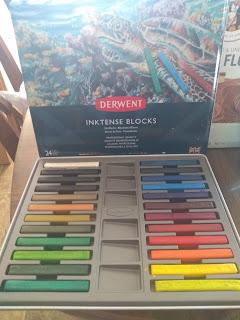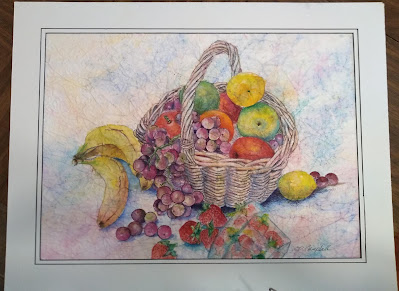This post is for paintings that you have tried everything on, but can't seem to save them. When you are desperate, ready to tear it up, and the painting has lost its life....but there's still an element worth trying to save.
These are, by all means, not the only measures you can take, but they might take you in a different direction.
#1 RECLAIMING WHITES
Sometimes you overwork the paper, lose your whites, and the paper loses its ability to control the paint. You might consider using a WATERCOLOR GROUND. Golden, QoR, and Daniel Smith all make ground, which turns your surface into one that will accept watercolor paints. You can use it on wood, plastic, glass, paper, etc.
If you are just covering a small amount of paper, just paint the ground over the paper that is ruined. Then you have to let it dry 24-48 hours. The directions tell you this, and believe me, you need to wait.Don't use a good brush to apply the ground. If you don't want to see brush strokes in the ground, roll over it with a small sponge paint roller. If it is still rough, you can use a little fine grit sand paper to remove the roughness.
Ground comes in several colors: Titanium, Transparent, Pearl, gold, black, buff, and others. I have used the black before to get a very black background that doesn't show brush strokes. In the yellow rose below, I tried to get a good black background, but the paint seemed uneven. The black ground was a great solution. (This was a rose tutorial from Louise DeMasi, but she had a white background)
White gouache is often used as a solution for adding whites or covering errors, especially in spattering snow in a snow scene. It is opaque. But you wouldn't want to try to paint over it, as it will make your paint look chalky.
If you just have a few tiny whites, you can try a white gel pen or pastel pencil.
Another possible product is called Bleed-proof White. Dr. PH Martins makes it, and so does Luma. In class I gave everyone a strip of paper with ground on one side and bleed-proof white on the other. They are both opaque and cover nicely. Bleed proof white will get chalky if you paint over it too much. You can lift on the ground.
INKTENSE BLOCKS
Below is my set of inktense blocks and the color chart beside it.
Always make a color chart, as the colors can be quite different than they look on the stick.
Before applying the rice paper.
Not all rice papers work for this project, but many do.
THINKING OUTSIDE THE BOX: USING CLEAR PLASTIC OVER A PAINTING
On a whim I used alcohol inks on clear acetate to create a design. Then I began to lay the design over some of my more boring paintings, and thought the affect was pretty interesting, turning a simple study into something that appears more abstract. Below you will see the peppers I painted in the recent blog about shadows overlaid with acetate that has alcohol ink design on it.
alcohol ink on acetate


































